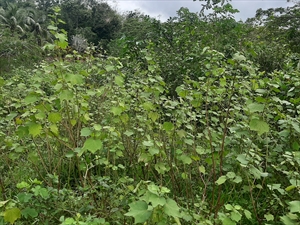Urena burr; it is also known as caesar weed, Chinese burr, Indian mallow, or Congo jute. CABI prefers caesar weed.
Pacific Pests, Pathogens, Weeds & Pesticides - Online edition
Pacific Pests, Pathogens, Weeds & Pesticides
Urena burr (468)
Urena lobata. Another species, Urena sinuata, is considered to be the same as Urena lobata by some taxonomists. A member of the Malvaceae.
Asia, Africa, North, South and Central America, the Caribbean, Europe (restricted), Oceania. It is recorded from Australia, American Samoa, Cook Islands, Federated States of Micronesia, Fiji, French Polynesia, Guam, New Caledonia, Niue, Northern Mariana Islands, Palau, Papua New Guinea, Solomon Islands, Tonga, Vanuatu, and Wallis & Futuna.
Probably, originated in tropical Asia; however, some think it is native to parts of northern Australia.
An aggressive invasive plant, fast-growing and capable of forming dense patches (Photo 1). Its invasiveness is due to ability to grow in a variety of soil types, different habitats - disturbed forests, pastures, waste ground, swamps, waterways, coastal dunes, roadsides, and perennial crop plantations. It grows from sea level to about 1500 masl.
An erect long-lived plant or small shrub, 0.5-2 m tall. Younger stems green, covered in star-shaped hairs; older stems woody. Leaves alternate along the stems, 4-10 cm long and 1.5-8 cm wide, borne on stalks, 1-9 cm long. Some lower leaves egg-shaped or somewhat circular, others with three or five lobes (Photo 2). Uppermost leaves smaller and narrower, 4-7 cm long by 1.5-3 cm wide. All leaves have toothed margins, pointed tips, and leaf surfaces covered in star-shaped hairs (Photo 3). Flowers, pink, 1.5-2 cm across, borne singly (sometimes more) on short stalks, 2-3 mm long, in the upper leaf forks. There are five pink or reddish-pink petals, 10-20 mm long, with numerous stamens (male parts), and a style (female part) that separates into 10 tiny branches near the tip (Photo 2). The round fruit, 6-10 mm across, turns from green to brown as it matures, eventually splitting into five, 1-seeded segments, covered in star-shaped hairs and numerous small, hooked spines (Photo 3). Each segment contains a kidney-shaped brown seed, 2-3 mm across.
Spread is by seeds. The fruits with hooked spines attach to animals' fur and people’s clothes. Seed is also spread by water, soil or contaminated agricultural produce. Urena burr was probably dispersed by humans throughout the tropical world from ancient times because of its use as a fibre plant. Others suggest that it was spread around the world by European voyages of the 18th century both as a fibre crops and for its medicinal properties.
Urena burr is an environmental weed (declared in Queensland, Australia), and has the potential to form dense thickets and alter plant ecosystems. There are also negative impacts on agriculture and forestry. Impacts are not well documented.
It was once grown in the USA for making ropes, and is still planted in Brazil for this purpose. It is a famine food in Africa. The seeds were used as a cereal and also for making soap. The roots and leaves were used for their antibacterial properties, and they were also used against fungi. There are many traditional medicines made from the weed, for the treatment numerous ailments: coughs, stomach aches, boils, sore throats, and more. It has been used to protect from soil erosion.
BIOSECURITY
The risk of introduction is high. Countries not yet infested should consider all likely pathways for entry, and apply quarantine measures accordingly. Particular attention should be given to the risks associated with seed that can be transferred on people's clothing.
Urena burr is classified as a noxious weed in Cuba, Fiji, and the USA - prohibited plant that must be controlled - they serve no economic purpose and possess characteristics that are harmful to humans, animals or the environment.
BIOCONTROL
None reported.
CULTURAL CONTROL
- Physical & Mechanical
- Hand weeding. Pull-up seedlings before plants flowers and form fruits.
- Hygiene
- Treat vehicles and farm machinery. If moving from areas where the weed occurs to those weed-free, wash to remove soil. This is equally important if the machinery is being imported into a country or moved within a country. Also, ensure seeds are not carried on clothes between infested and 'clean' areas.
CHEMICAL CONTROL
In Australia, MCPA is registered for use against urena burr. In Fiji, glyphosate.
--------------------
Note, EU approval to use glyphosate ended in December 2022, but it was extended till 15 December 2023; its use after that date is under discussion.
____________________
When using a pesticide, always wear protective clothing and follow the instructions on the product label, such as dosage, timing of application, and pre-harvest interval. Recommendations will vary with the crop and system of cultivation. Expert advice on the most appropriate herbicides to use should always be sought from local agricultural authorities.
AUTHORS Grahame Jackson, Aradhana Deesh & Mani Mua
Adapted from Urena burr (Urena lobata) (2018) Weeds of SE Qld and Northern NSW. Lucidcentral. (https://www.lucidcentral.org/editors-pick-animal-and-plant-identification-keys/key-to-weeds-of-se-qld-and-northern-nsw); and additional information from CABI (2019) Urena lobata (caesar weed). Invasive Species Compendium. (https://www.cabi.org/isc/datasheet/55771). Photo 4 Gerald McCormak, Cook Islands Biodiversity & Natural Heritage. (http://cookislands.bishopmuseum.org).
Produced with support from the Australian Centre for International Agricultural Research under project HORT/2016/185: Responding to emerging pest and disease threats to horticulture in the Pacific islands, implemented by the University of Queensland, in association with the Pacific Community and Koronivia Research Station, Ministry of Agriculture, Fiji.






